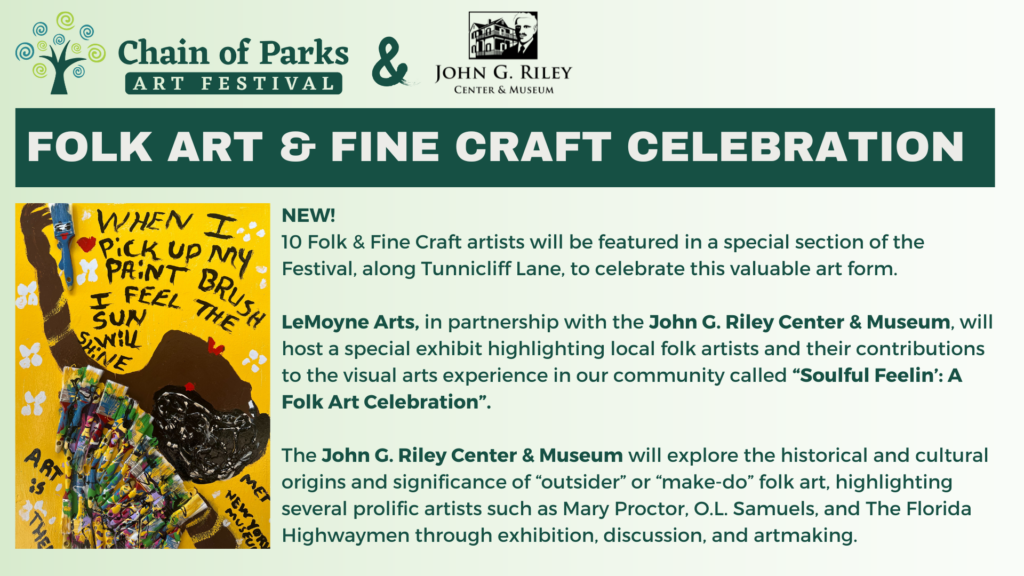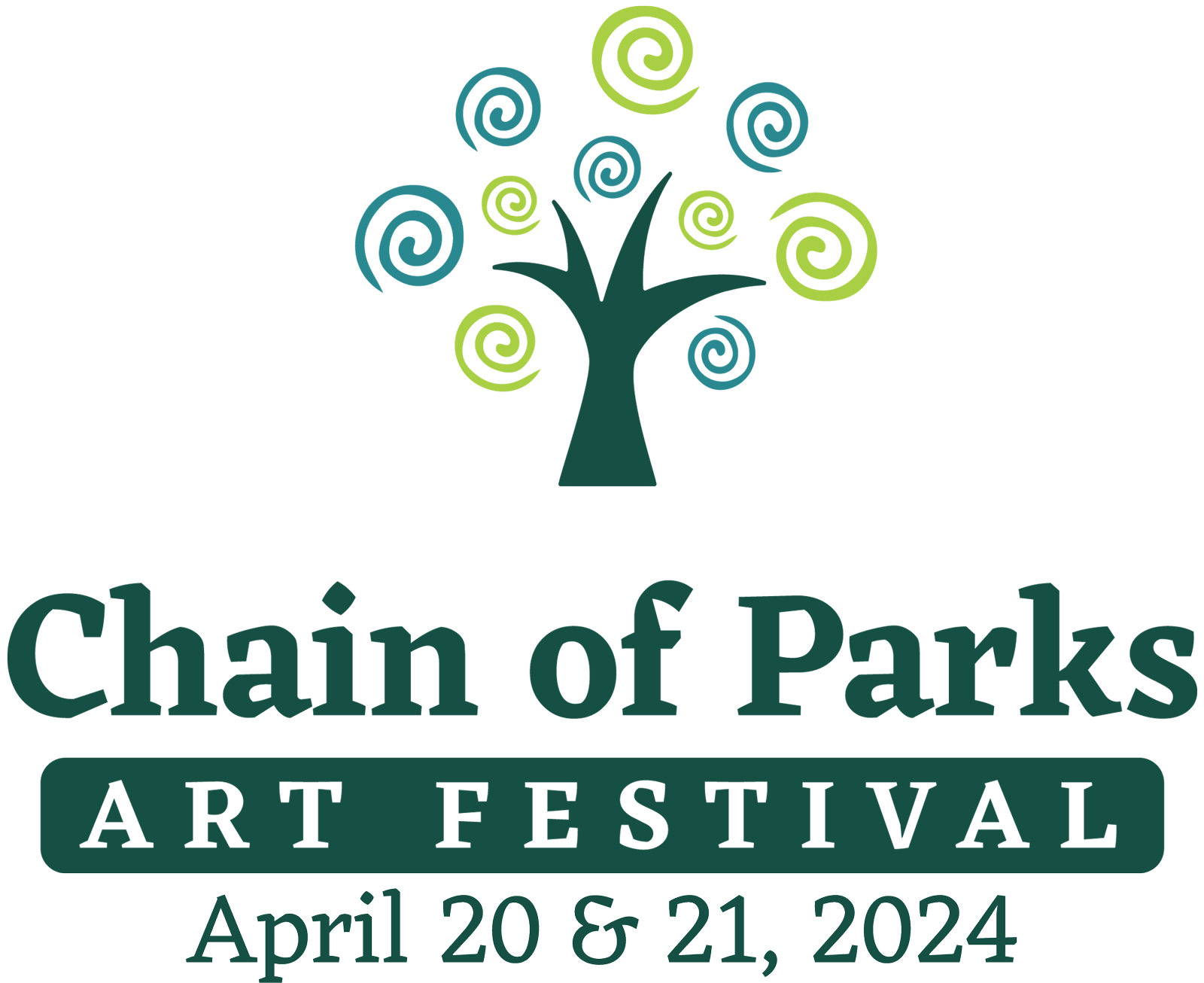Folk Art & Fine Craft Celebration
More 2025 info will be available in February! Follow us on social media for the latest updates.

Folk Art Celebration & Collaboration between LeMoyne Arts, the Chain of Parks Art Festival, and the John G. Riley Center & Museum!
LeMoyne Arts, in partnership with the John G. Riley Center & Museum, will host a special exhibit celebrating local folk artists and their contributions to the visual arts experience in our community. These exhibits will be in tandem with the 24th annual Chain of Parks Art Festival to showcase self-described folk artists from our region and beyond during the festival weekend.
“Soulful Feelin’: A Folk Art Celebration” LeMoyne Arts exhibit will be on display from Thursday, April 11 – Saturday, May 18, Kindly Presented Akbar Thomas, Personal Injury Attorneys.
The John G. Riley Center & Museum will explore the historical and cultural origins and significance of “outsider” or “make-do” folk art, highlighting several prolific artists such as Mary Proctor, O.L. Samuels, and The Florida Highwaymen through exhibition, discussion, and artmaking. Their exhibit will be on display in the Visitor Center from Friday, April 12 -Friday, May 10, with an open house on April 12 from 3 pm to 7:30 pm, and will feature a guest speaker, activities, and light refreshments.
The 24th Annual Chain of Parks Art Festival will be held on Saturday and Sunday, April 20-21, 2024. Visitors can view and purchase unique fine art creations from more than 150 artists from throughout the United States while enjoying a weekend filled with interactive children’s art activities, mouth-watering food, live entertainment, street art, local heritage re-enactments, and folk art!
While always featuring fine art, the Festival celebrates all of the arts, including music, dance, culinary art, street art, and now, folk art! Festival attendees will visit 10 self-described folk and fine craft artists along the festival’s Tunnicliff Lane leading to the exhibit at the LeMoyne Arts Gallery.
Art is one of the first languages of expression in history. From the initial engravings in caves to more sophisticated formulations now, people have used art to communicate, tell stories, and express their creativity. With time, different forms of art have emerged, each with its own unique style and purpose. Two such forms of art that people often compare and contrast are “fine art” vs. “folk art”.
While the differences are subjective and the definitions are constantly evolving, here’s a helpful guide to understanding the subtle distinctions between “Fine Art”, “Craft” and “Folk Art”.
Fine Art is typically described as a form of work that is the expression of emotions, executed from innate talent, passion, and classical training. The origins of fine art can be traced back to ancient civilizations, such as the Greeks and the Egyptians. Fine art was seen as a way to express one’s creativity and artistic talent. It was often created by professional artists who had received formal training in the techniques and theory of art.
Folk Art, on the other hand, has its roots in traditional cultures and communities. It is often created by individuals who have not received formal training in art but have inherited a style and skill through the traditions of a community. It is often passed down through generations and can be seen as a form of cultural heritage. Folk art is steeped in grassroots history and often distinguished from academic, commercial, and Western “Fine Art”. Folk Art is frequently demonstrated through fine craftmanship, utilitarian and ornamental media, color, and texture; showcasing artistic expression from a non-classically trained artist.
Generally, folk art is ART that:
- May be decorative or utilitarian
- Is handmade; it may include handmade elements, as well as new, synthetic, or recycled components
- May be made for use within a community of practice or it may be produced for sale as a form of income and empowerment
- May be learned formally or informally; folk art may also be self-taught
- Is traditional; it reflects shared cultural aesthetics and social issues. It is recognized that, as traditions are dynamic, traditional folk art may change over time and may include innovations in tradition.
- Is of, by, and for the people; all people, inclusive of class, status, culture, community, ethnicity, gender, and religion
Fine Craft is a form of work that results in a tangible output, often repeatable over and over. A fine craft can be learned from considerable practice and developed into a world-class form. Patrons are inspired by the skill to create the piece rather than a reaction to the subject matter.

“From childhood, I held tight to it with my use of color, and as I have practiced my art, I have felt my connection grow. I am a self-taught artist of Puerto Rican descent, experiencing Florida and deciphering it through my dreams, and my cultural identity comes out in my art. You could say that the folk heritage belonging of my art comes from my “naive” self-taught take on the Florida experience and is infused with my cultural identity which flows through my dreams, through my veins, and through my art.” ~Monica Rios
Click HERE to listen to WFSU’s story about this new folk art feature by Tom Flanigan.
“It’s always been a grassroots movement. Folk art comes from the people…it’s folks that feel the artistic challenge and step in and start creating. And they communicate their lives through their art.” ~Festival Chair, Kelly Dozier
